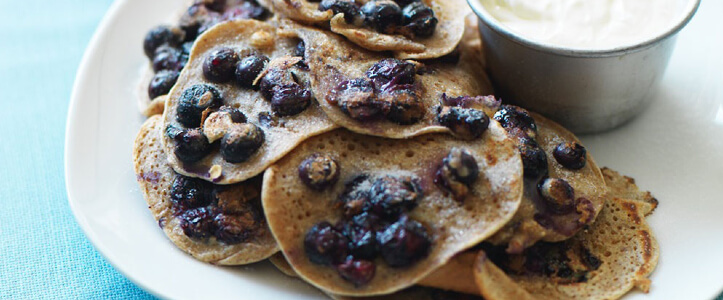
Shrove Tuesday or Pancake Day is the traditional day to eat pancakes in the UK, but they’re quick and easy to make anytime.
If you have type 1 or type 2 diabetes, or any other type of diabetes, you might be looking for some ideas to make your next batch of pancakes a healthier option. Here we give you some tips for healthier swaps to everyday baking.
We’ve got ideas for healthier toppings – sweet and savoury – plus tips if you’re gluten or dairy-free. Try our foolproof recipe below and get flipping...
Try our recipe for perfect pancakes.
Pancake ingredients
You’ll need just three ingredients: plain flour (you could try using wholemeal flour instead), one egg, and milk.
Simple switches for healthier pancakes
- Don’t add butter to the batter.
- Use a spray oil or measure your oil (1 tsp of oil is enough to cook eight pancakes if you use the same oil soaked into kitchen paper and wiped around your frying pan).
- Go for toppings like fresh fruit, natural yogurt, or chopped plain nuts which have no free (added) sugars and contain healthy fats.
Read on for advice on how to change some of the ingredients to make your pancakes healthier or to suit your diet.
Flour
Pancakes can be made with most flours: white or wholemeal, oat flour, rice flour or buckwheat. For a gluten free option, you can use gluten-free flour or even nut or rice flour.
Depending on the flour you choose, you can use this classic recipe as a guideline, but you may need a little more or less liquid as absorption rates vary. Different flours such as nut flours need a gentler heat to prevent burning. You can even make pancakes from potatoes for a savoury option.
Eggs and milk
Most pancakes contain egg, but not all. You can use egg substitutes for a vegan alternative. The liquid is milk or water or a mixture of both. If you’re looking for a dairy free version you could try soy, rice milk or nut milks, such as almond, which all work well too.
Top tips for top batter
Sift your chosen flour into a bowl. (This is to add air, so when sifting wholemeal flour you’ll be left with the wheat bran in the sieve. Just add this back into the sieved flour.)
Next, make a well in the middle of your flour. Add lightly beaten egg and half your liquid then mix into a smooth paste.
Gradually mix in the rest of the liquid and beat it until you have a smooth batter with no lumps. If using wheat flour, cover the batter and leave it to stand for 30 minutes to an hour. This relaxes the gluten and improves the texture of the pancakes, making them softer and less chewy.
Cooking tips
With any pancakes it’s important to get an even medium temperature across the pan – non-stick pans are the best option. You need virtually no oil if the temperature and consistency are right.
- Test the pan with a small pancake first to make sure it’s not too hot or too cool. Start with a low to medium heat and allow the pan to heat fully before adding the oil and batter.
- Add a little batter (2–3 tablespoons is plenty) to the pan and swirl it gently to spread the batter out thinly. Leave for 30–40 seconds, it should form a crust on the edges and the pancake will have bubbles in the middle.
- Ease the edges with a spatula and shake the pan. You should be able to move the pancake around without it sticking. It’s now ready to flip. You can use a large spatula or toss the pancake then cook the other side for around one minute.
Four steps to flipping a pancake
- A shallow-sided pan is best. (You can buy specific pancake pans, too.)
- Make sure the pancake is cooked and slides easily round the pan when shaken.
- Slide the pancake towards the handle then away from it a couple of times.
- Then, when shaking it, increase the speed and flick the pan upwards and away from you, only a few centimetres but quite vigorously. This should toss it onto the other side.
Best pancake toppings
Lemon juice and sugar are traditional toppings, but try a sugar alternative, such as a low-calorie granulated sweetener instead, with a squeeze of fresh orange.
You could also try chopped nuts, grated lemon or orange zest or unsweetened Greek yogurt and berries. Or you could go savoury with beetroot and cottage cheese, or prawn and avocado.
